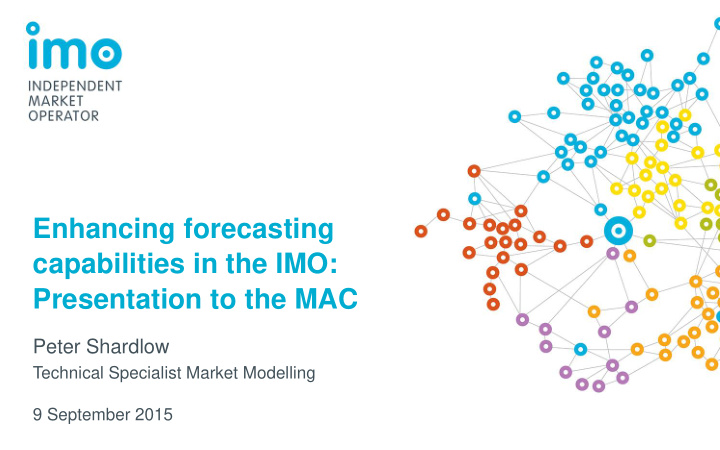



Enhancing forecasting capabilities in the IMO: Presentation to the MAC Peter Shardlow Technical Specialist Market Modelling 9 September 2015
Presentation Overview Technological innovation is changing electricity market fundamentals. • New technologies are providing exciting opportunities for market participants and customers. The IMO recognises the need to adapt to the evolving energy landscape. • Enhancing our forecasting and modelling capabilities to meet the challenges of changing conditions in the Western Australian energy market. We’re focused on delivering improvements in three key areas in FY16: • Long term demand forecasting; • Analysis of customer behaviour and segmentation; and • Modelling of small-scale solar PV and storage technology. 2
The electricity market is evolving in response to technological innovation Where we’ve been Where we’re heading Utilities focused on the safe, reliable delivery of Traditional consumer/producer model breaking reasonably priced electricity. down due to microgeneration and storage. Demand driven by population growth, economic Demand influenced by technology that gives activity, air conditioning sales and efficiency consumers control over how and when they use measures. energy. Internet-linked technology allowing for Little scope for dynamic interactions between continuous interaction between consumer, customer and supplier. retailer and wholesale market. 3
Our capacity to undertake detailed analysis of energy data is also improving New sources of information Improved analytical capabilities New Satellite Low cost IT Smart Live solar + cloud cover analytical infrastructure Metering storage data techniques data 4
Three focus areas for delivering improved forecasting and analysis at the IMO Long-term demand Customer behaviour Modelling of solar PV and forecasting analysis storage technology 5
Improving the IMO’s long -term demand forecasting capabilities Incorporation of new data sources (e.g. solar) into our Improved forecast accuracy. modelling. Benefit to participants More robust modelling and ability to IMO Deliverable Improved forecasting analyse variability over different time algorithms. horizons. Development of synthetic Better approach to understanding climate data and simulation climate-based demand variability. model. Integrated data visualisation Models become easier to interrogate tools. and more efficient to update. 6
Market Segmentation will focus on six questions to better understand energy use in Western Australia Market Segment Residential Industrial/Commercial Purpose What does the residential Which economic variables Validate critical forecasting customer demand profile impact customer energy assumptions with data. look like? demand? Will segmentation help us Have energy use patterns Improved understanding of understand the impact of changed significantly demand variability. changing demographics? since market start? Do household’s respond How are customers Inform market evolution and to solar by changing responding to wholesale policy development. consumption behaviour? market signals? 7
Analysis of metering data is providing insight into how customers are responding to market mechanisms Downward deviation Daily maximum aligned with high over 35°c temperature 2 1 Forecast temperature over 35°c, actual temperature was 28°c 3 8
Delivering improved small-scale PV and storage simulation models and analysis Project Real-time rooftop solar Improved battery Near-term rooftop solar generation data storage modelling forecasting (FY16) (FY16) (FY17) Deliverable Incorporate simulation Publish estimates of Use cloud cover data to modelling of battery small-scale solar PV forecast rooftop solar controller technology in generation in the SWIS. generation. the next ESOO. Better understanding of Benefit Provides participants with Better forecasts of net the opportunities and risks data for (unmetered) customer demand in the around small-scale solar generation. near future. storage. 9
How we’re using real -time data to gain insight into the impact of solar PV variability on the SWIS Figure 1: Estimated SWIS Rooftop solar production (% of maximum Rooftop Solar + Metered Generation output) 100% 75% Loss 50% Solar PV 10:30 75% 2,300 MW 25% 0% 11:00 25% +70 0:00 2:00 4:00 6:00 8:00 10:00 12:00 14:00 16:00 18:00 20:00 22:00 Figure 2: Historic and projected solar PV capacity, 2014 ESOO expected case 12:00 85% -100 1,500 1,000 Projected Historic 500 - 2009-10 2011-12 2013-14 2015-16 2017-18 2019-20 2021-22 2023-24 10
Three focus areas for delivering improved forecasting and analysis at the IMO Long-term demand forecasting Support the IMO and market participants in delivering on Customer behaviour analysis the Wholesale Electricity Market objectives Modelling of solar PV and storage technology 11
Project next steps Three ways the MAC can assist the IMO to deliver better analysis. The IMO’s forecasting work is not developed in a vacuum We would like feedback on how market participants use our analysis and how we can better align our deliverables with stakeholder requirements. We believe that transparency is paramount We believe there are opportunities to work with analysts from other organisations to obtain critical feedback on our methodology and results. We need assistance to understand new innovative technologies The market is evolving rapidly, and we need to adapt our modelling to capture the effects of innovative new technologies. 12
Recommend
More recommend